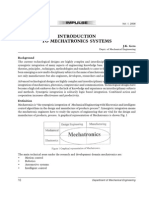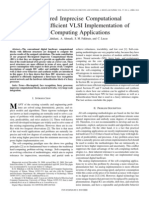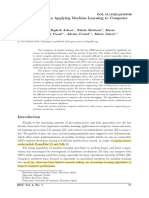A Top-Down Microsystems Design Methodology and Associated Challenges
A Top-Down Microsystems Design Methodology and Associated Challenges
Uploaded by
Vamsi ReddyCopyright:
Available Formats
A Top-Down Microsystems Design Methodology and Associated Challenges
A Top-Down Microsystems Design Methodology and Associated Challenges
Uploaded by
Vamsi ReddyOriginal Description:
Original Title
Copyright
Available Formats
Share this document
Did you find this document useful?
Is this content inappropriate?
Copyright:
Available Formats
A Top-Down Microsystems Design Methodology and Associated Challenges
A Top-Down Microsystems Design Methodology and Associated Challenges
Uploaded by
Vamsi ReddyCopyright:
Available Formats
A Top-Down Microsystems Design Methodology and Associated Challenges
Michael S. McCorquodale, Fadi H. Gebara, Keith L. Kraver, Eric D. Marsman, Robert M. Senger, and Richard B. Brown Department of Electrical Engineering and Computer Science Solid State Electronics Laboratory University of Michigan Ann Arbor, Michigan 48109-2122 ABSTRACT An overview of microsystems technology is presented along with a discussion of the recent trends and challenges associated with its development. A typical bottom-up design methodology is described and we propose, in contrast, an efficient and effective top-down methodology. We illustrate its implementation with the development of a microsystem design that has been completed and fabricated in CMOS technology. Gaps in the tool capabilities are identified and suggestions for future directions in CAD tool support for microsystems technology are presented.
MEMS
Analog
Mixed-Signal
Digital/VLSI
RFIC/RFMEMS
Sensor Sensor/Actuator Interface Actuator
ADC Baseband Modem Wireless Interface
Antenna
Microprocessor
DAC
Clock
FE Tools
AHDL Custom IC Tools
MS-HDL Custom IC Tools
VHDL Synthesis Tools
AHDL Custom RFIC Tools
1. Introduction
Microsystems technology is defined as an intelligent miniaturized system comprising sensing, processing and/ or actuating functions where two or more of the following technologies are combined onto a single or multichip hybrid: electrical, magnetic, mechanical, optical, chemical, or biological [1]. Building a complete microsystem involves several challenges as these designs include not only a union of the analog and digital circuit domains, but also the magnetic, mechanical, biological, chemical, or electrical domains. Moreover, the design constraints associated with systems such as these can be as specific as the material properties of a layer that defines a microstructure to as broad as an abstraction of the embedded processor that supports the firmware for the microsystem. A variety of tools for completion of such designs exist, but as yet, there is no complete end-to-end framework for development. In this work, we have aimed to leverage advances in integrated circuit CAD tools and couple them with trends in microelectromechanical systems (MEMS) and mixedsignal circuit design to address the challenges associated with the development of microsystems. We propose an efficient and effective design methodology for such development, while identifying gaps that call for new design automation developments.
Fig. 1: The anatomy of a generalized wireless integrated microsystem. Key technologies and associated development tools are shown.
2. Design Trends and Challenges Associated with Microsystems Technology
Fig. 1 illustrates a generalized end-to-end wireless integrated microsystem. Here the various technologies along with the typical design tools for each are illustrated. Tremendous breadth exists when developing such systems. For example, MEMS components are often devel-
oped with finite element (FE) tools that simulate mechanical response to an applied stimulus, while the microprocessor section is almost completely synthesized with some form of hardware description language (HDL). Digital IC design tools are now ubiquitous and offer the designer tremendous flexibility through system abstraction. Only recently have such trends developed in the analog and mechanical domains. There are several existing, and likely future, MEMS technologies that warrant integration with CMOS or a related process technology. Indeed a great deal of research has been underway in this field including activities in monolithic MEMS-based oscillators [2], accelerometers [3], and switches [4], to name just a few. Only recently have such subsystems been developed and thus ambiguity in a wholistic design flow and gaps in the related CAD framework are not surprising. Clearly, a design methodology for such systems that addresses the challenges associated with the convergence of these technologies is required if complete systems that implement these research breakthroughs are to ever come to fruition. Current and past development approaches have been typically ad-hoc and bottom-up in nature. This design methodology is an outgrowth of both the disparate nature of the technology and the process by which this technology has developed. Much MEMS work to date has been focussed on device development. Once device performance is optimized, supporting electronics are added incrementally. Therefore, a bottom-up development approach is rather natural. However, now these devices are appearing within much larger systems and the typical
development strategy is to partition sections of the microsystem into the mechanical, analog, or digital domains. Design activities become disjoint and ad-hoc from here, where each subsystem is designed with a separate tool suite and with little, if any, cross-domain verification. As discussed previously, MEMS technology has been designed almost exclusively with finite element tools, however the majority of these simulators do not support an interface with a standard IC framework. Therefore, in almost all applications, some level of model extraction and abstraction is required for simulation of the MEMS component with the supporting analog electronics. Often, this extraction is custom tailored to each component and it must be completed by the designer without the aid of design automation. Additionally, several of these systems require logic for programming or trimming, and in many applications a complete embedded processor is required to support the system. Here the standard tool suites allow designers to synthesize digital logic and physical design from a hardware description language, but typically verification is not performed with the analog and MEMS devices integrated into the microsystem. As Fig. 1 and the previous discussion illustrate, several disparate tools are required for the development of microsystems. Specific design challenges involve management of these tools as well as system verification across these various design platforms. Clearly, the number and complexity of tasks involved in the development of microsystems are significant. Attention to design methodology has become increasingly important in order to develop systems efficiently and close the design gap between manufacturing and design capabilities [5].
problems associated with a bottom-up design methodology are addressed. They include lack of architectural study and optimization, costly redesign effort associated with iteration through the flow, and significant processing time for system-level simulation, if it is even possible. Fig. 2 illustrates this typical design methodology as applied to microsystems technology. Here a system specification is translated into a specification for three domains: digital, analog, and mechanical. Design activities ensue from the device to block level and from the block to system level. A macro is delivered from each domain and the system is assembled with an automatic place and route (APR) tool. The system is then verified and only at this point are problems addressed. Therefore, time-consuming redesign effort is required back at the device level. Moreover, additional iterations are also common with the APR tool in order to optimize macro placement. Although methodologies such as these have been employed in the past, they are clearly insufficient for complex microsystems. As the field matures, it is likely that microsystems will contain several, if not hundreds, of magnetic, mechanical, optical, chemical, or biological components along with the supporting analog and digital devices. A proper, efficient, and exhaustive design methodology and framework is obviously required.
4. Proposed Design Methodology: Top-Down
The proposed design methodology has been implemented in the development of a complete microsystem, pictured in Fig. 3. The microsystem is comprised of five major subsystems: a microprocessor core, memory, peripherals, an analog front end (AFE), and a mechanically-tunable MEMS-based clock generator. The design was fabricated in Taiwan Semiconductor Manufacturing Companys (TSMC) 0.18m mixed-mode CMOS process and consists of approximately 1.5 million transistors that occupy a silicon area of 10.24mm2.
Tapeout
3. Typical Design Methodology: Bottom-Up
A bottom-up design methodology involves the development of each block from the device to system level. Devices are combined to form blocks, which are then combined to complete and verify the system. In [6], the
Verification: DRC, LVS (Top Routing Only), Parasitic Extraction and Backannotation (IC Tool)
Macro Automatic Place and Route (APR and IC Tool)
Digital Macro
Analog Macro
Mechanical Macro
Synthesis/APR/Timing (Synthesizer)
Analog Physical Design (IC Tool)
Digital Library
Digital Design (HDL)
Custom Analog Design (SPICE)
Custom Mechanical Design (FE)
Digital Specification
Analog Specification
Mechanical Specification
Process Library
System Specification and Design Partition
Fig. 2: Typical ad-hoc and bottom-up microsystems design methodology
Mechanical Domain
Analog Domain
Digital Domain
HDL which is a superset of the Verilog and Verilog-A languages. We have found that Verilog-AMS is also ideal for behavioral modeling of mechanical devices. Prior to the emergence of Verilog-A, many MEMS engineers had been using device level models, including primitives, for MEMS component modeling. Clearly, the Verilog-A language is a significant improvement over this technique as it provides added modeling flexibility while it minimizes complexity. Additional tools used in this work included Spectre for analog subsystem and transistor-level design, Coventorware for FE analysis of MEMS components, Synopsys for digital synthesis, Cadence Silicon Ensemble for APR, and Mentor Graphics Calibre for DRC and LVS. The requirement of such an extensive and disparate tool suite is a significant challenge faced in the development of microsystems technology.
4.2 Methodology
With a framework in place, a design methodology was determined, as illustrated in Fig. 4. Verilog-AMS was employed to realize the system specification. MEMS and analog components were modeled in Verilog-A, while the microprocessor core and peripherals were modeled in Verilog. From this system model, a natural partition of topdown subsystem design activities followed. Each block was specified with an abstraction for the hardware. In parallel with behavioral verification of the digital section, the blocks in the mechanical and analog domains were developed and performance metrics were determined. Updated Verilog-A was developed to model achieved performance from FE simulation in the mechanical domain while device-level design and analysis using Spectre led to achieving the analog specification. The digital electronics were developed such that a complete behavioral description of the hardware was realized. At this point, the first cross-domain verification of the system was achieved. Once the HDL from each domain had been updated with the achieved performance, verification of the system model was trivial. In the Cadence AMS environment, HDL and primitives may be mixed and critical subsystem performance metrics can be determined quickly with a detailed model for the subsystem and an abstract model for the remainder of the system. This was particularly significant when considering analog and MEMS device-level performance that required digital programming which was described only by HDL. A system-wide simulation was completed and iteration in the mechanical and analog design activities continued, dependent upon system performance. This first crossdomain simulation offered significant benefits over the bottom-up methodology described previously. First, design effort had not been expended synthesizing the digital electronics. Second, iteration in the design of the MEMS and analog circuits occurred early in the design flow. Last, the system simulation was fast as it was described by behavioral HDL, not a complete device-level netlist. However, simulation was also timely in the case of a primitive-level subsystem simulation as the remainder of the system is described by HDL and only the critical blocks were modeled at the device-level. System development continued with a typical physical design methodology. The digital sections were synthe-
Fig. 3: Die micrograph of the fabricated microsystem in TSMCs 0.18m mixed-mode process. MEMS components are released by post processing.
4.1 A Top-Down Approach
In a top-down approach, development would proceed from the system to device level. The system could be studied and optimized with a mixed-signal HDL (MS-HDL) from which the abstract circuit blocks are derived. Devicelevel designs would then be completed, and achieved performance could be benchmarked against the original specification using the abstract blocks and system model. Throughout a top-down design methodology, crossdomain verification at various levels should be budgeted. This reduces the likelihood of time-consuming redesign effort at higher levels of system assembly. In conjunction with the top-down approach, several additional development requirements were considered while constructing the design methodology. An environment that supports hardware abstraction and cross-domain simulation for MEMS, analog, and digital electronics was required. The environment also had to support simulation of abstract hardware with device primitives in order to accurately model digital programming of analog and mechanical components without synthesis of these digital devices. A model that could be modified easily for system verification based on the realized subsystem performance was desirable, as was cross-domain verification at every level of abstraction. The complete tool suite had to support low-level simulation including FE and basic transistorlevel analysis, as well as non-linear RF and noise analysis. Support for HDL synthesis, timing verification, and APR was mandatory for digital design and final chip assembly. Although no single design framework met all of these design requirements, we have found that the Cadence AMS environment is well-suited to achieving many of these goals for system-level development of microsystems technology. Our attention was first brought to this framework for the support of Verilog-AMS, an analog and digital
Abstract System Model (Verilog-AMS: Verilog and Verilog-A)
Digital Model (Verilog)
Analog Model (Verilog-A)
Mechanical Model (Verilog-A)
Behavioral Verification (Verilog)
Custom Analog Design (SPICE)
Mechanical Design (Finite Element)
Cross-Domain Verification (Verilog with updated Verilog-A from achieved performance and/or Verilog and Verilog-A with Primitives)
Synthesis/APR/Timing (Synthesis Tool)
Physical Design/Verification (IC Tool)
Physical Design/Verification (IC Tool)
Process Library
Digital Library
Extraction, Timing (Timing Tool)
Parasitic Extraction (IC Tool)
Parasitic Extraction (IC Tool)
Cross-Domain Verification (Verilog with updated Verilog-A from parasitics and/or Verilog and Verilog-A with Primitives)
Digital Macro
Analog Macro
Mechanical Macro
Macro Place and Route, Layout Verification: DRC, LVS (APR and IC Tool)
Layout Parasitic Extraction (LPE) and Backannotation (IC Tool)
Cross-Domain Verification (Verilog with updated Verilog-A with interconnect parasitcs)
Fig. 4: Proposed top-down microsystems design methodology
sized and the mechanical and analog sections were custom designed. Timing information from the synthesis tool was used in an iteration to achieve timing closure for the digital section. Similarly, parasitic extraction and backannotation afforded an iterative process in completing the mechanical and analog sections. Once timing closure was reached in each domain, a second cross-domain simulation was executed for system verification based on physical design. Again, the HDL for the subsystems was updated and system simulation was timely and accurate. Physical design iteration continued until timing closure was achieved for the complete system. The domain-specific design activities completed with the delivery of a hard macro. The final system development activities included APR, physical design verification (DRC, LVS), layout parasitic extraction (LPE), and backannotation. A final cross-domain verification was completed once parasitic extraction data for the interconnect between macros was determined. APR iteration was also necessary.
5. Gaps in the Tool Suite
Several CAD-related shortcomings were encountered throughout the development of this microsystem. All of these gaps are associated with the development of MEMS
and analog electronics. First, we have noted that the design tool suite used lacks support of a MEMS behavioral model that is automatically extracted from FE simulation. Likewise, an analog behavioral model that is automatically extracted from SPICE simulation is not supported. Throughout the physical design flow we encountered a lack of physical verification of the MEMS devices in primitive form. Synthesis libraries for MEMS and analog components from behavioral or topological models were also unavailable. As a result, porting capability of microsystem designs between process technologies through synthesis is not achievable. We have developed several custom and elementary patches for these design gaps in order to automate design flow. For example, a custom CV model for the tunable component contained within the on-chip clock generator was developed, and results from FE electrostatic simulation are ported to this model. Additionally, the lack of MEMS device verification was overcome by custom modification of the DRC and LVS decks. Trivial fixes include Verilog-A models that were updated by hand from achieved performance in Spectre. However, this process becomes time-consuming when considering complex analog subsystems. Other similar patches were employed and we believe that automation of patches like these would greatly facilitate microsystem designs of the future. Solutions to the other identified gaps are more diffi-
Mechanical Domain
Tapeout
Analog Domain
Digital Domain
cult. Analog and MEMS synthesis from HDL or a topol o g i c a l m o d e l i s i n d e e d a si g n i f i c a n t e n d e a v o r. Nonetheless, some tools for this very purpose [7] are available today and active research in this field in underway such as work shown in [8]. With these synthesis capabilities, the design would have been completed in a more timely manner.
7. References
[1] European Union 4th Framework, ESPIRIT Workprogramme, Sept. 1996. [2] D. J. Young, et al., A Low-Noise RF Voltage-Controlled Oscillator Using On-Chip High-Q Three-Dimensional Coil Inductor and Micromachined Variable Capacitor, SolidState Sensor and Actuator Workshop, pp. 128-131, 1998. [3] S. Lee, et al., Two-dimensional position detection system with MEMS accelerometer for mouse applications, Proc. Design Automation Conference, pp. 852-857, 2001. [4] G. M. Rebeiz and J. B. Muldavin, RF MEMS Switches and Switch Circuits, IEEE Microwave Magazine, vol. 2, issue 4, pp. 59-71, Dec. 2001. [5] K. Kundert, et al., Design of Mixed-Signal Systems on Chip, IEEE Trans. on CAD, vol. 19, no. 12, pp. 1561-1572, Dec. 2000. [6] K. Kundert, A Formal Top-Down Design Process for Mixed-Signal Circuits, Advances in Analog Circuit Design, April 2000. [7] D. Maliniak, Embedded Design Challenges hold center stage at the 39th DAC, Electronic Design, pp. 55-60, June 2002. [8] A. Doboli, et al., Behavioral Synthesis of Analog Systems using Two Layered Design Space Exploration, IEEE/ACM DAC, June 1999.
6. Conclusion
In this work we have presented an overview of microsystems technology and the trends and challenges associated its with development. A typical bottom-up design methodology was outlined and the associated shortcomings were addressed. By leveraging advances in mixedsignal and digital IC design tools, we have proposed an efficient and effective top-down design methodology. The methodology has been employed in the development of a complete microsystem. Gaps in the tool suite were presented as well as suggestions for future directions in CAD development. The authors aspire to promote appropriate tool development and integration so as to foster additional research activity in the field.
You might also like
- Nota Sains DLP Tahun 6Document30 pagesNota Sains DLP Tahun 6Umiey SafieNo ratings yet
- Design Structure Matrix Methods and Applications - The MIT PressDocument2 pagesDesign Structure Matrix Methods and Applications - The MIT PressVamsi Reddy33% (3)
- Digital Twin-The Simulation AspectDocument16 pagesDigital Twin-The Simulation Aspectjwpaprk1100% (4)
- GRADE 10 Math Q3 TOSDocument1 pageGRADE 10 Math Q3 TOSRudyr Bacolod100% (7)
- Gpa 2145 Table of Physical Constants For Hydrocarbons and Other Compounds of Interest To The Natural Gas Industr CompressDocument15 pagesGpa 2145 Table of Physical Constants For Hydrocarbons and Other Compounds of Interest To The Natural Gas Industr CompressSkolastikaPradiptaNo ratings yet
- Unit 1 INTRODUCTION TO MECHATRONICS SYSTEM DESIGNDocument8 pagesUnit 1 INTRODUCTION TO MECHATRONICS SYSTEM DESIGN9740177035100% (1)
- On The Suitability of Modeling Approaches For Engineering Distributed Control SystemsDocument6 pagesOn The Suitability of Modeling Approaches For Engineering Distributed Control SystemsPriyatham GangapatnamNo ratings yet
- Ieee PapersDocument8 pagesIeee PapersAtit PatelNo ratings yet
- Introduction To Mechatronics SystemDocument8 pagesIntroduction To Mechatronics SystemSomalia Wadankeyga100% (1)
- Implementing A Multi-Domain System: Siemens Digital Industries SoftwareDocument9 pagesImplementing A Multi-Domain System: Siemens Digital Industries SoftwareOscar MendozaNo ratings yet
- A Holistic Approach To Automated Synthesis of Mixed-Technology Digital MEMS SensorsDocument15 pagesA Holistic Approach To Automated Synthesis of Mixed-Technology Digital MEMS SensorstantdvnuNo ratings yet
- Cyber-Physical MBD For Multi-Physics Automotive Systems: Sujit S. Phatak DJ Mccune George Saikalis, Ph.D. Yasuo SugureDocument7 pagesCyber-Physical MBD For Multi-Physics Automotive Systems: Sujit S. Phatak DJ Mccune George Saikalis, Ph.D. Yasuo SugureoguierNo ratings yet
- NOTESDocument6 pagesNOTESPriyanka SheelavantarNo ratings yet
- A Framework For Developing A Microchip PIC Microcontroller Based ApplicationsDocument9 pagesA Framework For Developing A Microchip PIC Microcontroller Based ApplicationsBASEER AHMADNo ratings yet
- Effective Embedded Systems Software Design MethodologiesDocument6 pagesEffective Embedded Systems Software Design MethodologiesCS & ITNo ratings yet
- ICRA 2000 New Trends in Prototyping Design and Automation: Kokmeng - Lee@me - Gatech.eduDocument8 pagesICRA 2000 New Trends in Prototyping Design and Automation: Kokmeng - Lee@me - Gatech.eduMekaTronNo ratings yet
- Active SuspensionDocument6 pagesActive SuspensionSandor CleganeNo ratings yet
- VLSI Design FlowDocument10 pagesVLSI Design Flowuday93No ratings yet
- Computer Engineering As A DisciplineDocument5 pagesComputer Engineering As A DisciplineZaiyan GamingNo ratings yet
- Analysis and Simulation of Mixed-Technology VLSI SystemsDocument26 pagesAnalysis and Simulation of Mixed-Technology VLSI SystemscoralonsoNo ratings yet
- Tarea1 Lara GarcíaDocument5 pagesTarea1 Lara GarcíalaramecaNo ratings yet
- Overcoming Computational Errors in Sensing Platforms Through Embedded Machine-Learning KernelsDocument12 pagesOvercoming Computational Errors in Sensing Platforms Through Embedded Machine-Learning KernelsctorreshhNo ratings yet
- Elements of Model-Based Design: Jeff C. JensenDocument22 pagesElements of Model-Based Design: Jeff C. Jensenmsk_sunduNo ratings yet
- System-Level Power Optimization: Techniques and ToolsDocument78 pagesSystem-Level Power Optimization: Techniques and ToolsbluesoulNo ratings yet
- Mechatronic SystemsDocument25 pagesMechatronic SystemsRivisara VithanageNo ratings yet
- Final Year Project Report Writing GuidelinesV5.0Document8 pagesFinal Year Project Report Writing GuidelinesV5.0Ridzuan RahmanNo ratings yet
- Multiparadigm Modeling in Embedded Systems Design - Klaus D. Muller-Glaser, Gerd Frick, Erick Sax, Markus KuhlDocument14 pagesMultiparadigm Modeling in Embedded Systems Design - Klaus D. Muller-Glaser, Gerd Frick, Erick Sax, Markus KuhlMinh Đức TrầnNo ratings yet
- Systems On Chip: Evolutionary and Revolutionary TrendsDocument8 pagesSystems On Chip: Evolutionary and Revolutionary TrendsatsoumNo ratings yet
- Computing Curricula For The 21st Century: EducationDocument5 pagesComputing Curricula For The 21st Century: Educationsreejayan_sNo ratings yet
- 0180 Mukherjee-2000Document12 pages0180 Mukherjee-2000Asimov RiyazNo ratings yet
- VT Gridce - PsDocument32 pagesVT Gridce - PsssfofoNo ratings yet
- Model-Based Design Streamlines For STM32 Motor Control Embedded Software SystemDocument6 pagesModel-Based Design Streamlines For STM32 Motor Control Embedded Software SystemlakgoflakNo ratings yet
- Term Paper On Embedded SystemsDocument7 pagesTerm Paper On Embedded Systemsaflsbbesq100% (1)
- Bio-Inspired Imprecise ComputationalDocument13 pagesBio-Inspired Imprecise ComputationalJohn Leons E100% (1)
- 3 HomoheteroDocument43 pages3 HomoheteroAman ChaddhaNo ratings yet
- EIS Whitepaper PLM For Mechatronic Products 10 2009Document11 pagesEIS Whitepaper PLM For Mechatronic Products 10 2009khiladi2No ratings yet
- Model Based Design and SDR: Mansour Ahmadian, Zhila (Jila) Nazari, Nory Nakhaee, Zoran KosticDocument6 pagesModel Based Design and SDR: Mansour Ahmadian, Zhila (Jila) Nazari, Nory Nakhaee, Zoran Kosticparvathi69No ratings yet
- Rethinking Embedded Microprocessor EducationDocument6 pagesRethinking Embedded Microprocessor EducationRiyan AlviNo ratings yet
- 01 Mckelvin-ECBS2005 PDFDocument7 pages01 Mckelvin-ECBS2005 PDFBuzatu Razvan IonutNo ratings yet
- Discrete Event SimulationDocument140 pagesDiscrete Event Simulationssfofo100% (1)
- International Journal of Engineering Issues - Vol 2015 - No 2 - Paper4Document6 pagesInternational Journal of Engineering Issues - Vol 2015 - No 2 - Paper4sophiaNo ratings yet
- Chapter 2:基于模型的建模 & 连续动力学建模 & 系统的参与者模型Document69 pagesChapter 2:基于模型的建模 & 连续动力学建模 & 系统的参与者模型gs68295No ratings yet
- A Versatile Demonstrator For Distributed RealDocument4 pagesA Versatile Demonstrator For Distributed Realpriyanka1229No ratings yet
- Adopting Mbse and Sysml For Design of Electric Vehicle: Dassault Systemes India Pvt. LTDDocument3 pagesAdopting Mbse and Sysml For Design of Electric Vehicle: Dassault Systemes India Pvt. LTDRam Mohan Rao MakineniNo ratings yet
- Lecture 1 3Document62 pagesLecture 1 3Sivakumar PothirajNo ratings yet
- Mechatronic Model-Based Design Applied To An H-Bot RobotDocument18 pagesMechatronic Model-Based Design Applied To An H-Bot RobotMarian VerdeNo ratings yet
- Research Article: Survey of Mechatronic Techniques in Modern Machine DesignDocument10 pagesResearch Article: Survey of Mechatronic Techniques in Modern Machine DesignMahesh KanojiyaNo ratings yet
- Some Problems of Knowledge Based Control of Manufacturing Systems Using Open CommunicationDocument8 pagesSome Problems of Knowledge Based Control of Manufacturing Systems Using Open CommunicationNacsa JánosNo ratings yet
- Linking-Early-Mechatronic-System-Analysis-to-Physical-TestingDocument10 pagesLinking-Early-Mechatronic-System-Analysis-to-Physical-Testingtarik RymNo ratings yet
- A Practical Approach For Bus Architecture Optimization at Transaction LevelDocument6 pagesA Practical Approach For Bus Architecture Optimization at Transaction LevelAnh Tuấn TrầnNo ratings yet
- Real-Time Implementation of Low-Cost University Satellite 3-Axis Attitude Determination and Control SystemDocument10 pagesReal-Time Implementation of Low-Cost University Satellite 3-Axis Attitude Determination and Control SystemivosyNo ratings yet
- Visualized Simulation and Design Method of Mechanical System Dynamics Based On Transfer Matrix Method For Multibody SystemsDocument12 pagesVisualized Simulation and Design Method of Mechanical System Dynamics Based On Transfer Matrix Method For Multibody SystemsMilkiNo ratings yet
- A General Guide To Applying Machine Learning To Computer Architecture - MarkedDocument21 pagesA General Guide To Applying Machine Learning To Computer Architecture - MarkedMohammed Siyad BNo ratings yet
- Engineering of Computer-Based SystemsDocument18 pagesEngineering of Computer-Based SystemsMUSTAPHA SHEHU ABUBAKARNo ratings yet
- Recent Trends in Mechatronic SystemDocument11 pagesRecent Trends in Mechatronic SystemFaria Sultana MimiNo ratings yet
- Siemens SW Tanner MEMS Design Flow FS 81554 D2Document3 pagesSiemens SW Tanner MEMS Design Flow FS 81554 D2Mohamad RagabNo ratings yet
- 2021COAZ4108Document228 pages2021COAZ4108chithizeNo ratings yet
- FACULTY OF LAW PAST QUESTIONS 2019 2020 Till Date. (Compiled by Ola of Canada)Document12 pagesFACULTY OF LAW PAST QUESTIONS 2019 2020 Till Date. (Compiled by Ola of Canada)Ibidun TobiNo ratings yet
- Functional Verification Methodology of Chameleon Processor: 2 Description LevelsDocument6 pagesFunctional Verification Methodology of Chameleon Processor: 2 Description LevelsSeshanjali BurriNo ratings yet
- System On Chip SoC ReportDocument14 pagesSystem On Chip SoC Reportshahd dawood100% (1)
- 259 - Lecturer NotvfvvervrevDocument81 pages259 - Lecturer NotvfvvervrevBijay KumarNo ratings yet
- Chapter 1 PDFDocument127 pagesChapter 1 PDFAhmed Al-MasoodiNo ratings yet
- Micromachines 15 00247Document24 pagesMicromachines 15 00247n7yw4dh01No ratings yet
- Embedded Systems Programming with C++: Real-World TechniquesFrom EverandEmbedded Systems Programming with C++: Real-World TechniquesNo ratings yet
- Breeding: Erlangeri (Zedlitz, 1912) - The Fairly NumerousDocument1 pageBreeding: Erlangeri (Zedlitz, 1912) - The Fairly NumerousVamsi ReddyNo ratings yet
- Northern India Jammu and Kashmir Himachal Pradesh Gujjar Bakerwal Himachal Pradesh Tibetan Mastiff Indian Pariah DogDocument1 pageNorthern India Jammu and Kashmir Himachal Pradesh Gujjar Bakerwal Himachal Pradesh Tibetan Mastiff Indian Pariah DogVamsi ReddyNo ratings yet
- Rain QuailDocument1 pageRain QuailVamsi ReddyNo ratings yet
- DG 1Document1 pageDG 1Vamsi ReddyNo ratings yet
- List of Birds of Bangalore: Jump To Navigation Jump To Search Bangalore Karnataka India Nandi Hills Bannerghatta KaveriDocument2 pagesList of Birds of Bangalore: Jump To Navigation Jump To Search Bangalore Karnataka India Nandi Hills Bannerghatta KaveriVamsi ReddyNo ratings yet
- Kathewar Dog, Is A Breed of Sighthound From India: Saluki Karnataka Maharashtra Telangana MudholDocument1 pageKathewar Dog, Is A Breed of Sighthound From India: Saluki Karnataka Maharashtra Telangana MudholVamsi ReddyNo ratings yet
- Disadvantages of Corona DischargeDocument1 pageDisadvantages of Corona DischargeVamsi ReddyNo ratings yet
- Behaviour and Ecology: Francolin Indian Subcontinent Grey PartridgeDocument2 pagesBehaviour and Ecology: Francolin Indian Subcontinent Grey PartridgeVamsi ReddyNo ratings yet
- Current Density in A Round ConductorDocument3 pagesCurrent Density in A Round ConductorVamsi ReddyNo ratings yet
- KGFDocument3 pagesKGFVamsi ReddyNo ratings yet
- OnecoreffectDocument1 pageOnecoreffectVamsi ReddyNo ratings yet
- Indian PeafowlDocument2 pagesIndian PeafowlVamsi ReddyNo ratings yet
- Skineff 2Document2 pagesSkineff 2Vamsi ReddyNo ratings yet
- New Features in The New Release? Ans. Django's Latest Official Stable Version Is Django 2.2, It's The LTS Version and Will GetDocument1 pageNew Features in The New Release? Ans. Django's Latest Official Stable Version Is Django 2.2, It's The LTS Version and Will GetVamsi ReddyNo ratings yet
- Cause: Skin Effect Is The Tendency of AnDocument2 pagesCause: Skin Effect Is The Tendency of AnVamsi ReddyNo ratings yet
- Vision Robots ArticleDocument1 pageVision Robots ArticleVamsi ReddyNo ratings yet
- Corona Effect: Definition: The Phenomenon of Ionisation of Surrounding Air Around The Conductor Due To WhichDocument1 pageCorona Effect: Definition: The Phenomenon of Ionisation of Surrounding Air Around The Conductor Due To WhichVamsi ReddyNo ratings yet
- Contents: Corona EffectDocument1 pageContents: Corona EffectVamsi ReddyNo ratings yet
- Cars WeightDocument2 pagesCars WeightVamsi ReddyNo ratings yet
- Schlumberger IndiaDocument2 pagesSchlumberger IndiaVamsi ReddyNo ratings yet
- Java Equivalents in C#Document13 pagesJava Equivalents in C#Vamsi ReddyNo ratings yet
- 04.project Billing SystemDocument25 pages04.project Billing SystemHarish BoraNo ratings yet
- Unblock Your Abundance?: Tuesday, July 22, 2014Document3 pagesUnblock Your Abundance?: Tuesday, July 22, 2014Vamsi ReddyNo ratings yet
- Bhagavad Gita Best VersesDocument10 pagesBhagavad Gita Best VersesVamsi ReddyNo ratings yet
- 6 Reading MythsDocument3 pages6 Reading MythsVamsi ReddyNo ratings yet
- NTC Thermistors Type RL30: Uncoated Disc With Radial LeadsDocument2 pagesNTC Thermistors Type RL30: Uncoated Disc With Radial LeadsJonh G. GonzálezNo ratings yet
- MAE 301: Applied Experimental StatisticsDocument10 pagesMAE 301: Applied Experimental StatisticsmatthewNo ratings yet
- Aqa 84632H QP Jun18Document32 pagesAqa 84632H QP Jun18Sahil ChoudharyNo ratings yet
- FRS 2431Document62 pagesFRS 2431infoNo ratings yet
- 7.8inch E-Paper SpecificationDocument22 pages7.8inch E-Paper SpecificationfirsttenorNo ratings yet
- Garage Door ManualDocument40 pagesGarage Door ManualRachel DavisNo ratings yet
- Brief History of SemicondictorsDocument11 pagesBrief History of SemicondictorsAndres DecastroNo ratings yet
- WCCH2015 1 PathLoss and ShadowingDocument42 pagesWCCH2015 1 PathLoss and ShadowingTrong NđNo ratings yet
- SamplePaper02 PDFDocument16 pagesSamplePaper02 PDFCarl Agape DavisNo ratings yet
- lec06Document21 pageslec06Mustabshir Ibn AminNo ratings yet
- Root Cause Analysis of Inlet Hole and Leak Off Hole Operation Missing Problem in Cri Body Using Shainin Approach 1 Root Cause Analysis of Inlet Hole and Leak Off Hole Operation Mis..Document6 pagesRoot Cause Analysis of Inlet Hole and Leak Off Hole Operation Missing Problem in Cri Body Using Shainin Approach 1 Root Cause Analysis of Inlet Hole and Leak Off Hole Operation Mis..EngineerNo ratings yet
- JPM 12 00122 v2Document12 pagesJPM 12 00122 v2Taulant MukaNo ratings yet
- zOS V2R2.0 ISPF Messages and Codes - Isp2mc10 PDFDocument714 pageszOS V2R2.0 ISPF Messages and Codes - Isp2mc10 PDFJothisri KanagarajNo ratings yet
- Smex 10.2 IugDocument182 pagesSmex 10.2 Iugfirdous_soberNo ratings yet
- Rotation of AxesDocument5 pagesRotation of Axesmakrosha11816No ratings yet
- Cblephexpa 43Document13 pagesCblephexpa 43vishwakarmakritarthNo ratings yet
- Characteristics of Lightning StrokesDocument4 pagesCharacteristics of Lightning StrokesTigrilloNo ratings yet
- Form 3 44 Quadratic Equations and Graphs1Document22 pagesForm 3 44 Quadratic Equations and Graphs1abhayNo ratings yet
- SQL Server Administration Question TypeDocument8 pagesSQL Server Administration Question TypeMakaKotoNo ratings yet
- 3 CBLDocument65 pages3 CBLMuhammad ImranNo ratings yet
- Baqir - 2019 - Gas Turbine & SimulationDocument26 pagesBaqir - 2019 - Gas Turbine & SimulationMahnoorNo ratings yet
- Nuclear Drip LineDocument8 pagesNuclear Drip LineRobert HolemsNo ratings yet
- Tugas 7 Chapter 4 - G2J123024 Arjulita SariDocument8 pagesTugas 7 Chapter 4 - G2J123024 Arjulita Sariarjulita sariNo ratings yet
- Convertidor de Par y Toma de FuerzaDocument19 pagesConvertidor de Par y Toma de FuerzaDimitri IanNo ratings yet
- Optimal Fan Blade Design For Axial Stand FanDocument103 pagesOptimal Fan Blade Design For Axial Stand FanJoshua Raymund LuchavezNo ratings yet
- 13872-MSU Baroda Journalism PDFDocument2 pages13872-MSU Baroda Journalism PDFIrfan ShaikhNo ratings yet
- 1.3 Coxo Cob Strip Catalog - 202310v2-CompressedDocument95 pages1.3 Coxo Cob Strip Catalog - 202310v2-Compressedngranados1703No ratings yet



















































































































